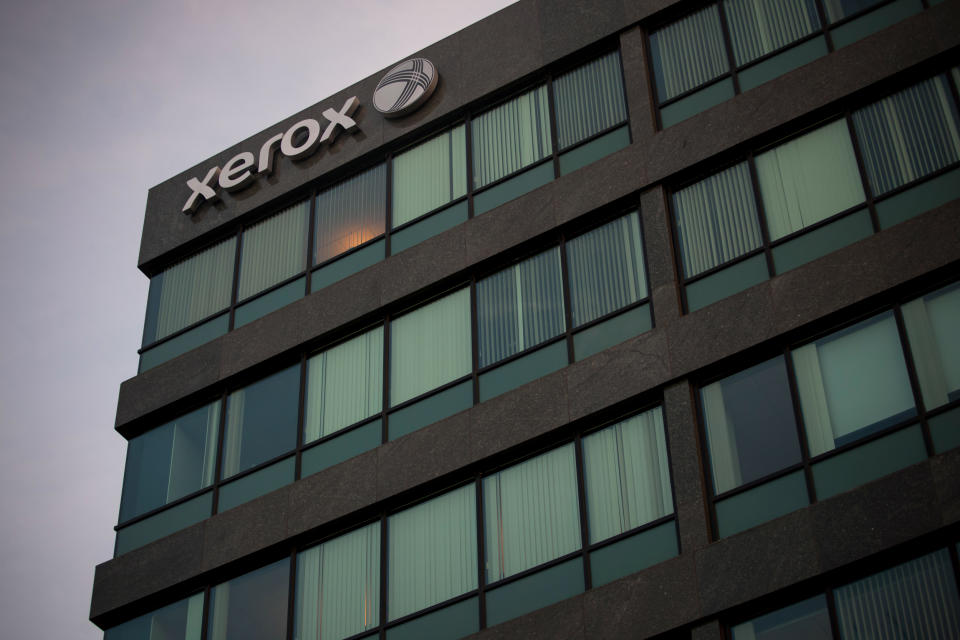Xerox plans to make low cost, disposable ventilators
WASHINGTON — Xerox, known for making copies, is set to announce Monday that it will be “rapidly scaling up” production of inexpensive, disposable ventilators that could serve as a critical stopgap for hospital-grade ventilators now in short supply amid the coronavirus pandemic, company officials said.
Xerox confirmed to NBC News that it has a deal with Vortran Medical, a small medical device manufacturer in California, to scale up production of the Go2Vent, a low-cost resuscitation device commonly used by first responders in emergencies and disasters.
The companies aim to produce 150,000 to 200,000 devices a month by June and could produce as many as 1 million ventilators in the coming months. They project making 40,000 ventilators this month alone. The Go2Vent is already FDA approved, has been on the market for years, doesn’t require electricity and is relatively inexpensive.
Xerox plans to charge hospitals approximately $120 per unit.
“The partnership with Xerox has one clear goal — to help save as many lives as possible,” Vortran's co-founder and CEO, Gordon A. Wong, MD, said in a statement. “For all of us, this will be the most important thing we ever do."

While the device is not a replacement for hospital-grade ventilators, it could help ease the pressure on states and health systems facing a crush of patients so severe that some hospitals have begun splitting ventilators to serve two patients at a time. At least another began using 3D printing to convert BiPap machines designed to be used for those with lung disease and sleep apnea.
“It takes off the overload on the system," so the sickest patients can go onto the ICU-grade ventilators, Naresh Shanker, Xerox’s chief technology officer, said in an interview.
Those exhibiting lower-level symptoms, whom studies show account for the majority of coronavirus patients, can significantly benefit from the Go2Vent, he said. The devices were widely used, for instance, around the Sept. 11, 2001, terror attacks in New York and during the SARS outbreak 17 years ago.
The deal will also give major manufacturers, including Ford Motor Co., the time they need to ramp up production of hospital grade ventilators, according to Sacramento-based Vortran.
Xerox says it plans to manufacture these FDA-approved ventilators and APM-Plus devices at its facility outside of Rochester, New York, where the company was founded and maintains a large presence, while Vortran will continue to make ventilators at its current facility in Sacramento, California.
The disposable Go2Vent can be set up within minutes and discarded after use by a single patient. It can be operated on a compressor and could provide ventilatory support for up to 30 days.
“Given the shortage of ICU-grade ventilators, medical professionals are utilizing tools like this and other technology to support patients who do not yet or no longer need an ICU-level breathing device, which can be freed up for another patient,” the companies said in a statement.
Dr. Timothy Albertson, the chair of internal medicine at UC Davis whose expertise includes adult respiratory distress syndrome, said the units would be welcomed by health care professionals.
“Our nation needs all the help we can get," he said. "ICU ventilators are in short supply and will be so for the foreseeable future. This proven, simple low cost ventilator can help fill the gap in the meantime. Doctors, nurses and respiratory therapists need all the help they can get. And fast.”
Shanker said it is aiming to produce 1 million units “as needed” and based on global demand.
Several governors are warning that the ventilator shortage is dire as the death toll climbs from the coronavirus. Gov. Andrew Cuomo of New York said prices for hospital-grade ventilators had shot up to $50,000, “if you can find them.” While federal officials have already sent more than 4,000 ventilators to the state, Cuomo has said first responders expect to need 30,000 to 40,000 ventilators in the next two weeks.
Many governors are saying they are facing bidding wars between states and the national government. Ventilators cost $5,000 to $50,000.
A recent American Hospital Association estimate projected that 4.8 million patients would be hospitalized, with 1.9 million admitted to the Intensive Care Unit, and 960,000 requiring ventilation. Yet the total number of ventilators in the country is estimated at roughly 170,000, including in hospitals and the National Stockpile.
The companies are also producing a battery-operated portable device that connects to the Go2Vent and to monitor patients and their key respiratory parameters.
Wong said that over the last few weeks Vortran has been approached by multiple businesses, academic institutions, and several ad hoc groups seeking a possible arrangements to manufacture, distribute and sell the device.
“All along, my priority was finding the right company or group who could deliver the most ventilators to the largest number of hospitals in the shortest possible time,” Wong said of the arrangement with Xerox.
CORRECTION (April 7, 2020, 5:00 p.m. ET): An earlier version of this article misspelled the last name of Xerox’s chief technology officer. He is Naresh Shanker, not Shankar.

